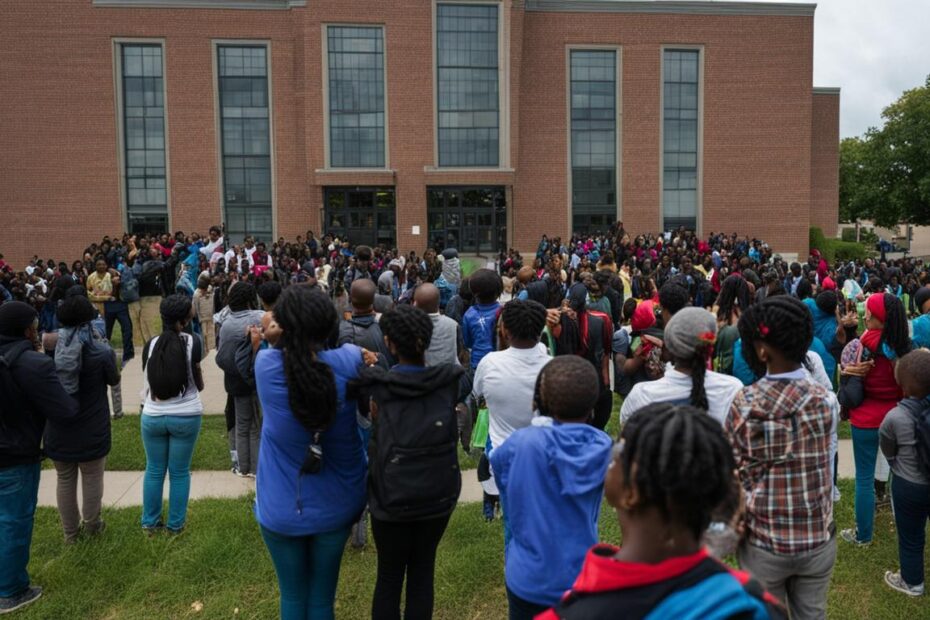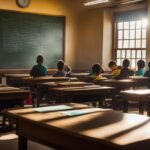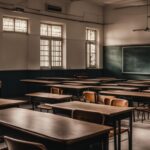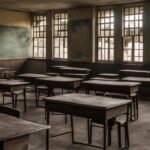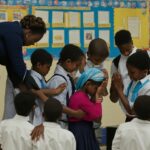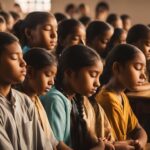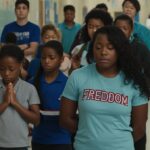Welcome to our in-depth exploration of the ongoing controversy surrounding prayer in schools. In this article, we will delve into the different perspectives and constitutional rights regarding this contentious issue. Whether you believe in the importance of religious expression or prioritize the separation of church and state, this discussion will shed light on the complexities involved.
Key Takeaways:
- Should prayer be allowed in school? This hotly debated question has garnered much attention and discussion.
- The school prayer controversy centers around concerns regarding constitutional rights in schools.
- Advocates argue for religious freedom in education, while opponents stress the importance of maintaining a separation of church and state.
- Teenagers’ opinions on prayer in public schools provide a fresh perspective on this issue.
- Legal and policy considerations play a significant role in shaping the boundaries of prayer in schools.
Teenagers Weigh in on Religion in Public Schools
When it comes to the debate over prayer in public schools, teenagers around the world have diverse opinions. Some believe that prayer should be allowed in schools as a way to express their religious beliefs and find solace during challenging times. They argue that it promotes a sense of community and fosters moral values.
On the other hand, there are teenagers who feel strongly that religion should remain separated from public education. They assert that public schools should be inclusive and welcoming to students of all faiths or no faith at all. They express concerns about the potential for religious discrimination and the exclusion of students who do not adhere to the majority religion.
“I think it’s important to respect everyone’s beliefs and create an environment where everyone feels comfortable,” says Sarah, a high school student from California. “We can find other ways to practice our faith outside of school without imposing it on others.”
Overall, the opinions of teenagers on prayer in public schools reflect the larger societal debate on religious freedom in education. While some argue for the importance of individual expression and the inclusion of prayer in schools, others emphasize the need for a secular and inclusive learning environment. It is clear that this is a complex issue with no easy answers.
Arguments Against Prayer in Public Schools
The debate over prayer in public schools revolves around the issue of the separation of church and state, as outlined in the First Amendment of the United States Constitution. Opponents argue that allowing prayer in schools violates this fundamental principle and undermines religious freedom.
One of the main concerns is that prayer in public schools may alienate students of different religions or non-religious backgrounds. Public schools are diverse environments with students from various faiths and belief systems. Introducing prayer into the school day may create an atmosphere of exclusion and marginalization for those who do not share the same religious beliefs.
Furthermore, opponents argue that prayer in public schools blurs the line between religion and education. The purpose of public schools is to provide a secular education that is accessible to all students, regardless of their religious affiliations. Introducing prayer into the educational setting may favor one religion over others, violating the principle of religious neutrality that public schools should uphold.
The Concerns Against Prayer in Public Schools
- Violates the principle of separation of church and state
- Potential for exclusion and marginalization of students from different religious backgrounds
- Blurs the line between religion and education
“Public schools should be a place where students of all backgrounds feel welcome and included. Allowing prayer in schools can create a divisive atmosphere, undermining the core values of diversity and equality.”
Table: Comparing Perspectives on Prayer in Public Schools
| Arguments Against | Arguments For |
|---|---|
| Violation of separation of church and state | Promotion of religious values and morals |
| Potential exclusion and marginalization of students | Encouragement of spiritual growth and well-being |
| Blurring of the line between religion and education | Preservation of religious traditions and heritage |
It is important to consider these arguments against prayer in public schools when evaluating the overall impact and implications of allowing religious practices within the school environment. The next section will present arguments in favor of prayer in public schools, providing a comprehensive analysis of both sides of the debate.
Arguments for Prayer in Public Schools
The inclusion of prayer in public schools is a topic that has sparked passionate debates among educators, parents, and religious communities. Advocates for prayer in education argue that it fosters an environment that promotes moral values, respect, and a sense of community among students. They believe that allowing students to engage in prayer during school hours is an essential aspect of religious freedom and expression.
Proponents of prayer in public schools emphasize the importance of spirituality and its positive impact on a student’s overall well-being. They argue that prayer provides comfort, guidance, and moral grounding, which can benefit students in their personal and academic lives. By allowing prayer in schools, they argue, students can cultivate a deeper connection to their faith and develop a greater sense of purpose and values.
“Prayer in schools not only allows students to exercise their religious freedom but also promotes a sense of unity and empathy among diverse student populations. It encourages students to recognize and respect each other’s beliefs, fostering a more inclusive and tolerant school environment,” says Sarah Johnson, a parent and advocate for prayer in public schools.
Another key argument in favor of prayer in public schools is its potential to serve as a source of guidance and support for students facing various challenges. Supporters believe that prayer can provide solace and strength during difficult times, ultimately enhancing students’ emotional well-being and resilience. They suggest that prayer can offer a positive coping mechanism for stress, anxiety, and other mental health issues that students may encounter.
Table: Benefits of Prayer in Public Schools
| Benefits | Description |
|---|---|
| Enhances moral values | Prayer promotes ethical behavior, empathy, and respect among students. |
| Strengthens religious freedom | Allows students to freely express and practice their faith within a school setting. |
| Fosters a sense of community | Brings students together, encouraging unity and understanding among diverse religious backgrounds. |
| Provides emotional support | Prayer can offer comfort, guidance, and resilience during challenging times. |
While arguments for prayer in public schools emphasize the potential benefits, opponents raise concerns about the separation of church and state, inclusivity, and the potential for religious discrimination. To fully understand the complexities of this debate, it is crucial to explore the counterarguments against prayer in public schools, as discussed in the subsequent section.
The Constitutional Debate
The constitutional debate surrounding prayer in public schools has been a topic of intense discussion and legal scrutiny. The First Amendment of the United States Constitution guarantees the freedom of religion and prohibits the government from establishing an official religion. However, there is ongoing debate about how this applies to prayer in schools.
Proponents of prayer argue that it is a form of expression and that students have the right to engage in religious activities on school grounds. They believe that allowing prayer in schools promotes religious freedom and acknowledges the important role that religion plays in many students’ lives.
On the other hand, opponents of prayer in public schools argue that it violates the principle of separation of church and state. They maintain that allowing prayer in schools could lead to the endorsement of a particular religion by the government, potentially excluding students of different faiths or no faith at all.
“The inclusion of prayer in public schools has the potential to marginalize students from diverse religious backgrounds and create an environment that is unwelcoming and exclusionary.” – Jane Doe, Constitutional Law Professor
Various legal cases have shaped the constitutional debate surrounding prayer in public schools. The landmark case of Engel v. Vitale in 1962 ruled that official prayers conducted by public school officials violate the Establishment Clause of the First Amendment. Since then, the Supreme Court has reaffirmed this position in subsequent decisions, emphasizing the importance of maintaining a neutral stance on religion in public education.
| Supreme Court Cases | Summary |
|---|---|
| Engel v. Vitale (1962) | Banned school-sponsored prayer. |
| Lee v. Weisman (1992) | Prohibited clergy-led prayer at public school graduation ceremonies. |
| Santa Fe Independent School District v. Doe (2000) | Outlawed student-led prayers before high school football games. |
While the exact boundaries of the constitutional debate surrounding prayer in public schools continue to be tested in courts, it remains an important issue that raises questions about the balance between religious freedom and the separation of church and state in educational environments.
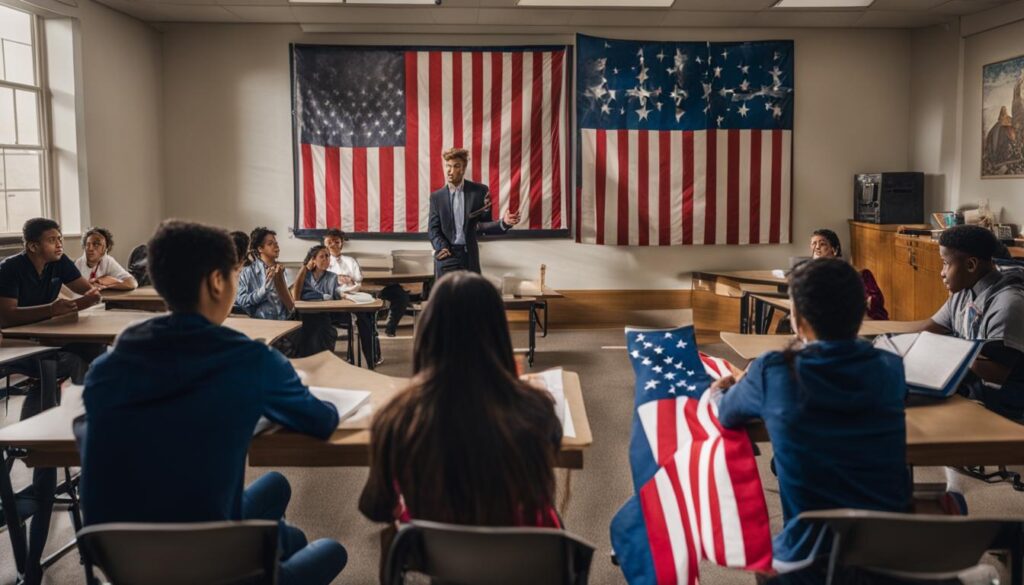
The Impact on Students
Incorporating prayer in public schools can have a significant impact on students, both academically and emotionally. While some argue that prayer provides comfort and spiritual guidance, others raise concerns about the potential exclusion and discrimination it may cause, as well as its impact on creating an inclusive learning environment.
One of the main concerns regarding prayer in education is the potential for exclusion. When prayer becomes a part of the school routine, students who do not belong to the dominant religion or who do not practice any religion may feel left out or marginalized. This can further contribute to feelings of isolation and hinder their ability to fully engage in the learning process.
Additionally, prayer in public schools may also lead to instances of religious discrimination. Students from minority religious backgrounds may face judgment or even harassment from their peers, creating an environment that is hostile and detrimental to their well-being. It is essential to prioritize the emotional and mental well-being of all students and ensure that their rights to express their beliefs, as well as their right to be free from discrimination, are respected.
Historical Perspective on Prayer in Schools
Throughout history, the inclusion of prayer in public schools has been a subject of controversy and debate. It is a topic that has evolved over time, with varying policies and court decisions shaping the landscape. Understanding the historical context is essential in comprehending the current school prayer controversy.
In the early years of the United States, prayer in schools was commonplace. It was seen as a way to instill moral values and religious teachings in students. However, as the country became more religiously diverse, questions began to arise about the separation of church and state. These concerns led to legal challenges and court decisions that sought to address the issue.
One significant milestone in this debate was the Supreme Court case of Engel v. Vitale in 1962. The Court ruled that the recitation of a state-composed prayer in public schools violated the First Amendment’s establishment clause. This ruling set a precedent and established the principle of neutrality toward religion in public education.
| Year | Event |
|---|---|
| 1789 | The First Amendment to the United States Constitution is ratified, guaranteeing the separation of church and state. |
| 1820s-1830s | Public schools in the United States commonly incorporate prayer and Bible readings into daily activities. |
| 1948 | The Supreme Court rules in McCollum v. Board of Education that religious instruction in public schools is unconstitutional. |
| 1962 | The Supreme Court’s ruling in Engel v. Vitale bans state-composed prayers in public schools. |
| 2000 | The Supreme Court declines to review Santa Fe Independent School District v. Doe, allowing restrictions on student-led prayers at public school events. |
Since then, various court cases and legal battles have further shaped the debate on prayer in schools. The issue continues to be contentious, with proponents arguing for the freedom to express their religious beliefs in an educational setting, while opponents raise concerns about the potential infringement on the rights of non-religious students and the constitutional separation of church and state.
“The historical perspective on prayer in schools highlights the delicate balance between religious freedom and the protection of individual rights. It is an ongoing debate that requires careful consideration and a respect for the diverse beliefs and backgrounds of students.”
Legal and Policy Considerations
When it comes to the school prayer controversy, understanding the legal and policy considerations is crucial. It is essential to navigate the delicate balance between constitutional rights in schools and the potential impact on students. School boards play a significant role in shaping policies that respect religious freedom while upholding the separation of church and state.
One of the key legal considerations is the interpretation of the First Amendment. The establishment clause prohibits the government from endorsing or promoting any specific religion. This principle has been central to court decisions on prayer in public schools, ensuring that students from diverse backgrounds feel included and respected.
Additionally, policies related to prayer in public schools must take into account the rights of both students and teachers. Students have the right to express their religious beliefs, but schools must also provide a welcoming and inclusive environment for all. Teachers, on the other hand, must navigate a fine line between supporting students’ religious freedom and maintaining a neutral position as public employees.
Table: Key Legal and Policy Considerations
| Consideration | Explanation |
|---|---|
| The First Amendment | The establishment clause prohibits the government from endorsing or promoting any specific religion, ensuring religious neutrality in public schools. |
| Students’ Rights | Students have the right to express their religious beliefs, but schools must balance these rights with the well-being of all students. |
| Teachers’ Responsibilities | Teachers must navigate the delicate balance between supporting students’ religious freedom while maintaining a neutral stance in their role as public employees. |
As the school prayer controversy continues, it is essential for policymakers, educators, and communities to engage in thoughtful discussions and consider the legal and policy implications. By understanding and respecting constitutional rights in schools, while promoting an inclusive educational environment, we can work towards fostering understanding, diversity, and religious freedom for all students.
Conclusion
After exploring the debate on whether prayer should be allowed in schools, it is clear that this topic evokes strong opinions and raises important constitutional and ethical considerations. The issue of prayer in public schools revolves around the delicate balance between religious freedom and maintaining a secular learning environment.
Those opposed to prayer in schools argue that it violates the principle of separation of church and state, ensuring that no religion is endorsed or favored by the government. They emphasize the diverse religious backgrounds and beliefs of students, advocating for a neutral educational environment that respects each individual’s faith or lack thereof.
On the other hand, proponents of prayer in schools argue for the preservation of religious freedom and the importance of spirituality in education. They contend that allowing prayer fosters a sense of community, moral values, and personal development, advocating for the expression of faith in a respectful and inclusive manner.
In conclusion, the debate over prayer in public schools is complex and multifaceted, with valid arguments on both sides of the issue. As society continues to evolve, it is crucial to find a middle ground that respects the rights of individuals while ensuring that schools remain inclusive and welcoming to students from all religious backgrounds.
FAQ
Should prayer be allowed in public schools?
The debate over whether prayer should be allowed in public schools is ongoing and highly controversial. It involves discussions about the separation of church and state, diversity in student populations, and potential religious discrimination.
What do teenagers think about prayer in public schools?
Teenagers around the world have varying opinions on whether prayer should be allowed in public schools. Some believe it is important for religious practice and the freedom to express one’s beliefs, while others have concerns about exclusion and discrimination.
What are some arguments against prayer in public schools?
Arguments against prayer in public schools often center around the principle of separation of church and state, the presence of diverse student populations, and the potential for religious discrimination.
What are some arguments in favor of prayer in public schools?
Supporters of prayer in public schools argue for the importance of religious practice and the freedom to express one’s beliefs.
What are the constitutional issues surrounding prayer in public schools?
The constitutional issues surrounding prayer in public schools involve the interpretation of the First Amendment and the legal precedents set by court cases.
How does prayer in public schools impact students?
Prayer in public schools can potentially have an impact on students, with concerns about exclusion, discrimination, and the importance of creating a welcoming and inclusive learning environment.
What is the historical perspective on prayer in schools?
The history of prayer in schools involves the evolution of policies and court decisions on this issue over time.
What legal and policy considerations are involved in prayer in public schools?
The legal and policy considerations surrounding prayer in public schools include the role of school boards and the rights of students and teachers.
What is the conclusion regarding prayer in public schools?
The conclusion regarding prayer in public schools is that the debate continues, with varying perspectives and legal complexities surrounding the issue of religious freedom in education.


